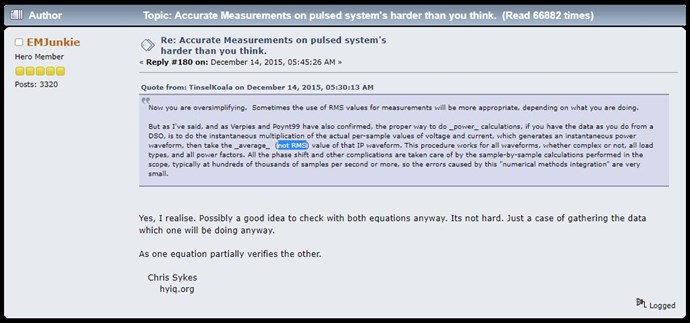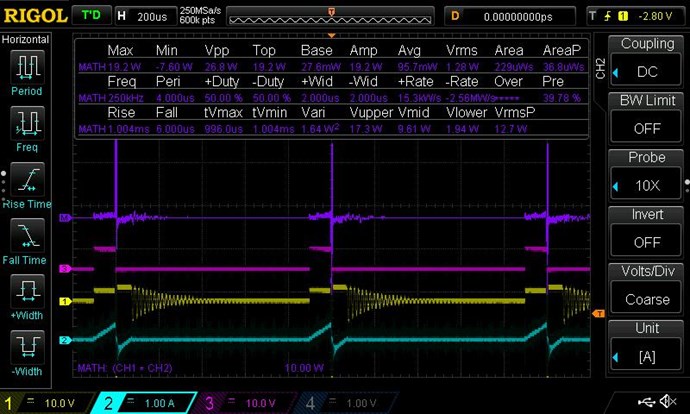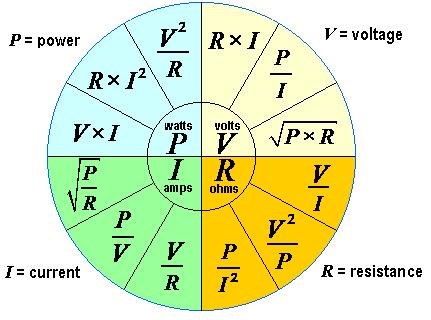Since Itsu is not a member here ( I hope he will one day) and since we sometimes exchange ideas, I asked his permission to pass on his experiences on the RMS average comparison, As we have to examine the question from different angles this is of interest.
From Itsu
OK, now using a 12V / 5W lamp, same setup 1Khz @ 10% duty cycle:

Screenshot shows the:
# voltage in yellow across the 12V / 5W bulb
# current in green through the 12V / 5W bulb (current probe)
# Power in red calculated by the scope (Ch1 x Ch4)
I measure BETWEEN the 2 yellow vertical cursors only, so all data in the result box ONLY points to data take from the traces between those cursors which is 1 full period (cycle)
So we see that this period (1ms long) has a mean value of 1.166V and a rms value of 3.755V, and the current measures 192.9mA rms for which the scope calculated power (red) to be 723.6mW.
I have put 2 DMM's across the 12V / 5W bulb and:
# the Fluke 179 true RMS meters says 1.174V
# A cheapo DMM (no true rms) says 1.168V
Both DMM's of course measure the whole signal, so many periods (cycles).
It shows that a pulsed DC square signal has different value's for Vavg and Vrms.
The 12V bulb is on, but dim, so the 723mW seems an OK value for this 5W bulb.
Therefor the Vrms value of 3.755V seems the correct one as 3.755 x 0.1929 = 724mW which is the same almost as the scope calculates.
So both DMM's show the wrong voltage as they show the average voltage (mean) which cannot be used for this power calculation.
Itsu
My experience with this setup:
10 Ohm 1% CSR loaded with 10V DC pulse 1KHz @ 10% duty cycle.

Screenshot shows the:
# voltage in yellow across the 10 Ohm
# current in green through the 10 Ohm (current probe)
# Power in red calculated by the scope (Ch1 x Ch4)
I measure BETWEEN the 2 yellow vertical cursors only, so all data in the result box ONLY points to data take from the traces between those cursors.
So we see that this pulse (98us long) has both mean and rms value of 10V, and the current measures 1.01A for which the scope calculated power (red) to be 10.1W.
I have put 2 DMM's across the 10 Ohm resistor and:
# the Fluke 179 true RMS meters says 0.984V
# A cheapo DMM (no true rms) says 0.978V
Both DMM's of course measure the whole signal, so including the 10% duty cycle, therefor its ~10 times lower in value.
Not sure what you want with this, but it shows to me that a pulsed DC square signal has the same value for Vavg as for Vrms.
For the melnichenko setup, i yesterday tried 3 different methods to measure / calculate the input power:
1) using my voltage and current probe at the PS entry of the circuit.
This shows i have 36V DC @ 129.7mA rms AC for which the scope math function calculated the mean power to be 4.42W
2) using your method "Urms_pulse=Vp√D" where for:
voltage my t1 is 72us and T is 770us thus D = 0.093, Vp is average 32.9V, so giving Vrms to be 10.06V rms
current my t1 is 72us and T is 770us thus D = 0.093, Ip is 2.8A, but triangled, so halved for square so is 1.4A, so giving I rms to be 427mA rms
Power then is V rms x I rms = 10.06 x 427mA = 4.29W
3) A 2th way to calculate I rms in the above 2) method is to use the triangle formula "Urms_triangle_ = Vp√t1/3T" which gives 2.8A x √72/3*770 = 2.8A x 0.1765 = 494mA rms
This multiplied by Vrms 10.06V gives 4.97W
So we got input powers: 4.42W, 4.29W and 4.97W by different measurement / calculations.
Each method has its own parameters, and although i tried to measure them as best as i can, none will be exactly right due to several fluctuations thus this outcomes.
But overall, if i would have to pick the most correct one i will vote for method 1.
Jagau for Itsu
All ideas are interesting to observe as you can see
Jagau

















